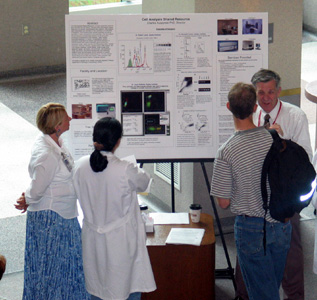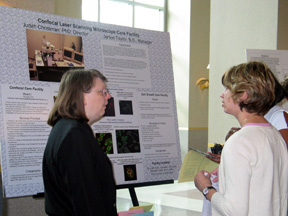 The UNMC Vice Chancellor for Research Office recently sponsored its first Shared Resources Core Facilities Day to promote awareness of UNMC’s core facilities and highlight collaborative research opportunities on campus.
The UNMC Vice Chancellor for Research Office recently sponsored its first Shared Resources Core Facilities Day to promote awareness of UNMC’s core facilities and highlight collaborative research opportunities on campus.
For four hours, representatives from 24 of the more than 40 core facilities presented posters describing the services they offer investigators.
“It was a wonderful way to raise awareness about our core facilities and set the stage for face-to-face interaction and greater collaboration,” said Paula Turpen, Ph.D., associate vice chancellor for research at UNMC.
Core facilities, sometimes called shared resources, provide sophisticated, expensive technology and expertise that no single lab would have the financial resources to purchase and learn. These fee-for-service resources help investigators maximize productivity by providing access to technologies, services and scientific consultation at a reasonable cost. Core facilities also provide stability, reliability, cost-effectiveness and quality control that would be difficult to achieve otherwise.
In July, the UNMC Vice Chancellor for Research Office queried nearly 700 faculty members about each of the UNMC core facilities that receive funding from the Nebraska Research Initiative. On average, Dr. Turpen said, 30 percent of the 200 responders didn’t know what services were provided by particular core facilities. “For some, the level of awareness about a particular core facility was as high as 60 percent,” Dr. Turpen said. “For others, it was as low as 20 percent.”
 The survey was helpful, Dr. Turpen said, in knowing what types of services are offered and whether there is duplication among the core facilities, which are administered by individual departments. Similar information is being sought for the University of Nebraska-Lincoln campus, she said.
The survey was helpful, Dr. Turpen said, in knowing what types of services are offered and whether there is duplication among the core facilities, which are administered by individual departments. Similar information is being sought for the University of Nebraska-Lincoln campus, she said.
“The event allowed core facility directors to interact with potential customers, as well as other core facility personnel,” she said.
In the future, Dr. Turpen hopes to further unify the core facilities via a Web page and phone directory page.
During the event, participants learned about one of UNMC’s newest pieces of equipment – an analytical ultracentrifuge, which gives low-resolution structural information of a protein, said Paul Sorgen, Ph.D. It is the first of its kind in Nebraska.
Nearby, LuAnn Larson of the Clinical Research Center told participants how the Clinical Research Center supports investigator-initiated studies, while the Clinical Trials office supports industry-sponsored studies. “Our face is becoming better known,” Larson said, of the center in University Tower, Room 3445. For the past nine years, the center has provided funding, as well as space, for physician pilot projects and has trained coordinators.
Another core facility, the Bioinformatics and Molecular Modeling Facility, helps investigators mine large amounts of data. Under the direction of Simon Sherman, Ph.D., the center helps life science researchers and clinicians analyze, store and define data, as well as build molecular models.
“Data is just numbers,” Dr. Sherman said. “We turn data into information and information into knowledge.”
The shared core facilities event also highlighted the Technical Advancement Group (TAG). Established in 1997, TAG provides resources to add value to UNMC’s intellectual property and increase the technology’s commercialization potential. Located in Wittson Hall, TAG has had 26 projects to date, said Annika Weber, associate director of TAG.